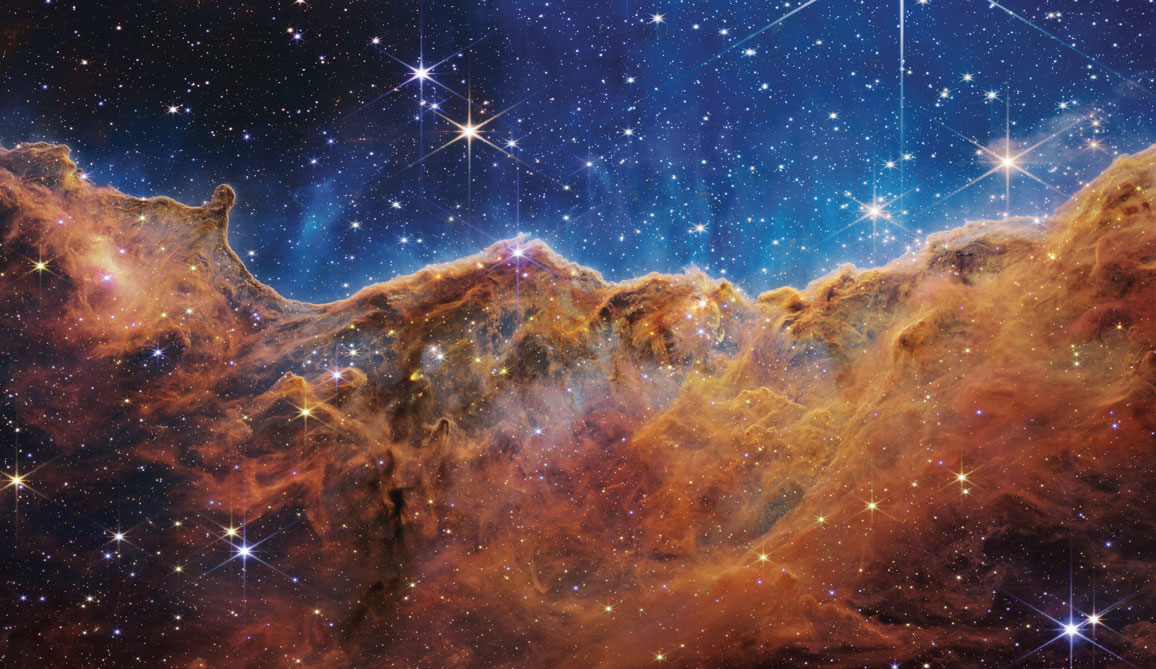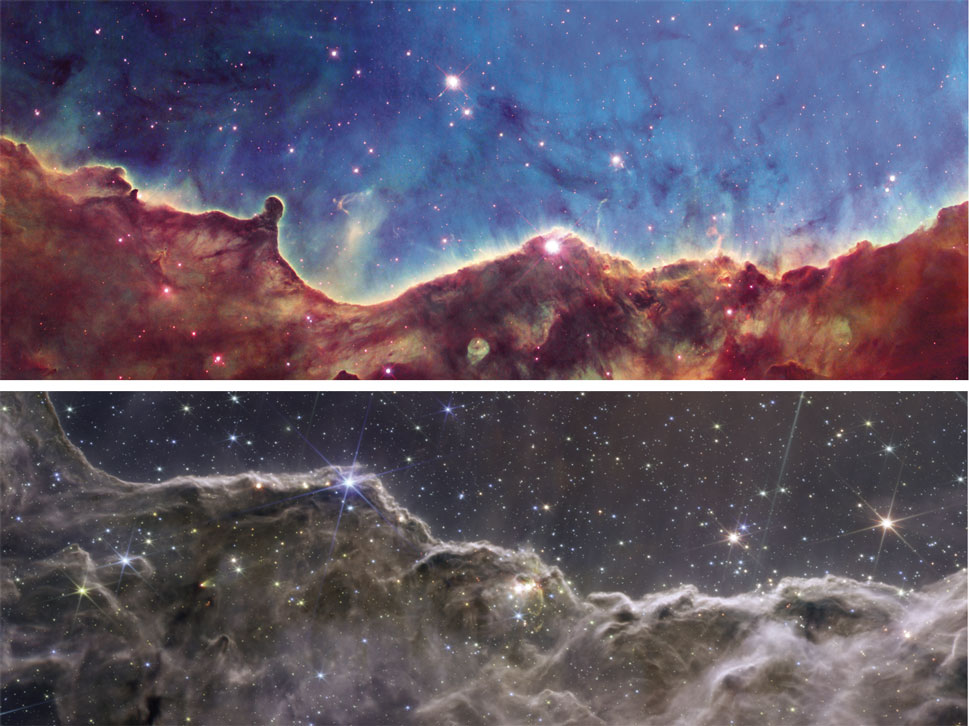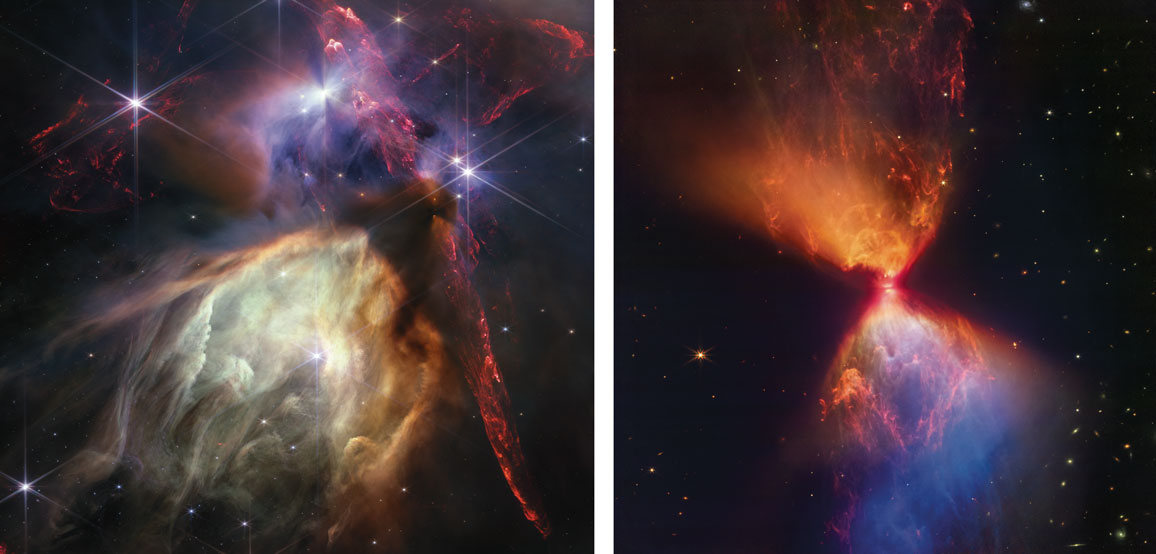The Birth of Stars
By Caroline Harper
The James Webb Space Telescope offers exciting glimpses of our cosmic history.
The James Webb Space Telescope offers exciting glimpses of our cosmic history.

The James Webb Space Telescope (JWST) is a phenomenal feat of engineering. Since it was launched on Christmas Day in 2021 from the European spaceport in French Guiana, the telescope, with its giant mirror and specially designed instruments, has been pushing back the boundaries of what astronomers thought was possible, making inspirational scientific discoveries, and providing researchers with enough new data to keep them busy for many years to come.
The predecessor to JWST was NASA’s Hubble Space Telescope, which was launched in 1990. Hubble was only supposed to operate until 2005, but it is still going strong, sending us incredible images of stars, galaxies, and other structures as they form and evolve. However, Hubble uses primarily visible and ultraviolet (UV) light to observe the universe; it is not designed to see anything that only emits longer wavelengths of light, in the infrared range of the spectrum. This limitation is a problem because we know that light traveling toward Earth from faraway luminous objects gets stretched into longer wavelengths as the universe expands, carrying the objects further from us. Light waves from a distant star may begin their journey as UV or visible light but will be stretched and become infrared light on the way. So if we want to see very distant objects, we cannot use Hubble. Also, because light takes time to travel to us, the most distant objects we see are also the oldest, which means Hubble does not let us see the earliest stars and galaxies.
JWST was designed to work using infrared light, so that we could see the first stars and galaxies that formed after the Big Bang. Its ability to see in the infrared also means that we can use it to peer into the dense dust clouds surrounding new stars being born and old stars dying—dust that is impenetrable to visible light.
JWST is 100 times more powerful than Hubble. This increased power is due to the size of its main mirror; whereas Hubble’s mirror has a diameter of 2.4 meters, JWST’s mirror is 6.5 meters across—so big that it could not be launched in one piece and had to be built in 18 huge segments that folded up inside the launch vehicle and then opened up and aligned in space.
JWST contains four instruments that take light collected by the mirrors and turn it into electrical signals for processing: the near-infrared camera (NIRCam), the near-infrared spectrograph (NIRSpec), the mid-infrared instrument (MIRI), and the fine guidance sensor/near-infrared imager and slitless spectrograph (FGS/NIRISS). Three of the instruments—NIRCam, NIRSpec, and FGS/NIRISS—operate in near-infrared wavelengths between 0.6 microns and 5 microns, close to the visible light that the human eye can see. MIRI works, as the name suggests, farther out in the mid-infrared range, between 5 microns and 28 microns. MIRI adds to the capabilities of the other instruments by enabling the telescope to study the thick dust enshrouding newly forming stars, galaxies, and planets.
The first images released from JWST, just a few months after launch, were focused on faraway galaxies and star-forming nebulae. JWST’s primary goal is to tell us more about our cosmic history by viewing the distant, early universe in more detail than ever before, using its state-of-the-art infrared capabilities.
When science operations began, one of JWST’s first targets for exploration was the Carina Nebula, a gigantic region of gas and dust located almost 7,500 light-years away from Earth in the heart of the Carina constellation. The Carina Nebula is of interest because enormous clouds of dust and gas are the birthplaces of stars in our universe. How stars come into being, and how they contribute to the structure and evolution of the universe, are some of the big questions in astronomy today, and when researchers want to learn more about how stars are born and develop in our galaxy, the Carina Nebula is one of the first places they look. It was discovered way back in 1752, but so far we have only been able to guess at many of its secrets. Now, JWST’s infrared eye is allowing it to penetrate the dust and see right inside with exquisite clarity and detail for the first time. The resulting images are providing a treasure trove of scientific data, unseen until now.

NASA, ESA, CSA, and STScI. Image processing: J. DePasquale (STScI).
The stunning image of the Carina Nebula’s Cosmic Cliffs above was taken by JWST’s NIRCam. The different wavelengths of infrared light have been converted into colors that we can see, to allow us to interpret the image. The nebula is a vast region, hundreds of light-years across. It looks solid in the image, but in reality it is made up of gases (mainly hydrogen) and dust, the building blocks of stars. We can see a lot of stars here, and inside the cloud of dust and gas we know there is a huge star nursery, where many more stars of different sizes are born, including some really massive stars that are 100 times bigger than the Sun. These giant stars burn very hot and have short lifespans, just a few million years—the blink of an eye for our Sun, which has a life expectancy of 10 billion years. Lower-mass stars such as our Sun are more common, but they are harder to see as they are forming and interacting with their surroundings. Now, JWST is helping us to observe more baby stars as they develop inside the cloud.
To begin with, some of the matter in the nebula gets drawn together by gravity and begins to rotate, gathering more material from the cloud of dust and gas around it, especially molecular hydrogen. As the material starts to clump together, the temperature increases, and when it gets hot enough at the core, nuclear fusion of the hydrogen begins. During this process, as the name suggests, the hydrogen nuclei fuse together. This process creates helium and releases a lot of energy, which keeps the core very hot. Once fusion begins, the object can truly be designated as a star.
Star creation is not a one-way process—new stars also propel some of their gas and dust back out again as they are developing. These releases take the form of outflows of molecular hydrogen and penetrating protostellar jets, which are flung outwards from the poles of the developing star at astonishing speeds, pushing into the surrounding cloud of gas and dust, carving out enormous cavities, and sculpting an incredible landscape of towering peaks and valleys, breathtaking pillars, and cliffs. The pressure from these fast-moving jets creates bow shocks and triggers unstable material at the edges of the cavities to collapse inwards, clumping together and eventually forming yet more stars—beginning the process over again.
The jets happen when new stars in early development, known as protostars, are actively accumulating material from the surrounding cloud, a process known as accretion, which may only last a few thousand years—not long at all in cosmological terms. This short duration, coupled with the fact that new stars are always shrouded in dense cocoons of dust, makes them hard to find and observe. Scientists were eagerly awaiting JWST’s arrival to allow them to watch these young stars, and the outflows and jets emerging from their accretion zones, with greater resolution than ever before.

NASA, ESA, and the Hubble Heritage Team (STScI/AURA); NASA, ESA, CSA, and STSd
It is worth noting that Hubble had been observing the Carina Nebula for more than a decade before the launch of JWST. With Hubble, we can still see some newly forming stars, but visible light cannot penetrate the dust, so our view is limited (see image above, top). But it was Hubble’s observations that identified many targets, such as the Carina Nebula, for JWST to observe. Also, using both telescopes to double-image the same sites provides us with a bonus—it allows us to compare the speed and direction of some of the jets and to see how they have changed over time, helping us to understand how active the star-forming regions are.
We can learn even more by viewing the nebula with MIRI as well as NIRCam (see image above, bottom). The cloud appears paler now, and inside it we can pick out hundreds of previously hidden stars glowing brightly, with the youngest ones swathed in thick dust and appearing as red dots and smudges, and the older ones appearing bluer. The newly maturing stars produce UV radiation, which blasts holes in the gas and dust, contributing to the sculpted shapes in the nebula. Near the edge of the cloud in the center of the image, there is an enormous bubble of material bursting out from the cloud, highlighted here in gold; MIRI can see into the dust and has pinpointed the star that has caused it. Behind the cloud itself, we can see many more points of light—these are distant galaxies in the background.

NASA, ESA, CSA, STScI, Klaus Pontoppidan (STScI); NASA, ESA, CSA, and STScI. Image processing: J. DePasquale, A. Pagan, and A. Koekemoer (STScI).
Exactly a year after we saw these very first images from JWST on July 12, 2022, NASA released a beautiful shot of a small star-forming region in the Rho Ophiuchi cloud complex, just 390 light-years away (see image above, left). It is actually the closest star nursery to Earth, with not much in between to obscure our view, so it affords us a particularly clear, close-up view of what is going on. There are around 50 stars shown here, most of them roughly Sun-sized or smaller; this is how our Sun would have looked as it was forming. There is one exception—the star in the center of the image is much more massive than the other stars and has blasted out an enormous cavern in the surrounding dust and gas, shown glowing yellow and gold in the photo. The rest of the image is full of huge jets of molecular hydrogen, represented in red, which are being released as the young stars burst out of their dust shrouds for the first time. Some of the stars have protoplanetary disks around them, heralding the formation of new solar systems. The wealth of sharp detail in this unobstructed image will be studied for a long time to come and will provide scientists with new insights into star and planet formation.
Studying all of these images and the scientific data they contain in more detail will allow us to answer many outstanding questions about star birth. We know that stars are the basic units of the universe, producing most of the energy that drives its processes, including the formation of planets from the debris around themselves and clustering together to create swirling, spiraling galaxies. But what determines how many stars form and what they are made of? What governs how big they will be and how long they will exist? We know that many stars form in small groups and others in larger clusters, but we are not sure why. Nor do we fully understand how young stars cause the formation of planets around themselves. By looking at how young stars interact, evolve, and take in and release material to their surroundings, we can begin to shed light on how our universe came to be the way it is.
Back in our own galaxy, in the Taurus constellation (around 460 light-years from Earth), JWST has captured stunning pictures of a huge, distinctively shaped cloud of dust and gas surrounding a protostar, dubbed the "Fiery Hourglass" by NASA, revealing previously hidden features (see image above, right). The protostar L1527 itself is hidden in the narrow neck of the hourglass, and the small, dark bar across the middle of the neck is an accretion disk of protoplanetary material surrounding the star, viewed edge-on. The star is still drawing dust and gas in from the hourglass cloud, gradually creating the disk. The dramatic cloud cannot really be seen when viewed in visible light wavelengths, but with JWST we can see light in the infrared, streaming out from the newly forming star like a fiery blaze and illuminating the gas and dust.
The false color in this image enables us to visualize the infrared light as JWST can see it. The blue color represents areas where the dust is thinner, whereas the orange color represents areas of thicker dust that trap more of the light. There are not many stars here, and for very good reason—the protostar is ejecting some of its material so violently that it is producing enormous bow shocks and turbulence, much like a boat moving rapidly through the water on Earth. This turbulence produces giant filaments of molecular hydrogen, appearing here as glowing orange threads lacing the clouds. In the case of the Fiery Hourglass, this turbulence is so significant that it is actually preventing material from clumping and inhibiting the formation of other stars, leaving our protostar to dominate the cloud and claim most of the material in it for itself.
L1527 is only about 100,000 years old. It is of great interest to astronomers because it is in the very early stages of star formation and is so far only 20 to 40 percent of the mass of the Sun. This baby protostar will not qualify as a mature star with its own nuclear fusion reactor for a long time. It will continue to gather mass, which it will compress, becoming hotter and hotter, eventually triggering fusion. The disk may look tiny here in comparison to the hourglass as a whole, but it is about the same size as our Solar System, so the view of the newly forming star in L1527 gives us an idea of what our Sun and Solar System might have looked like as they were developing around 4.5 billion years ago.
The nebula 30 Doradus is nicknamed the Tarantula Nebula because the shape of its dust clouds is reminiscent of a gigantic spider. It lies in the Large Magellanic Cloud (LMC) galaxy, one of our nearest neighbors in the Local Group—the group of around 20 nearby galaxies to which the Milky Way belongs. It is the brightest star-forming region in the whole group, and lurking within it are some of the hottest, most massive stars we have ever observed.

NASA, ESA, CSA, STScI, Webb ERO Production Team
The image above (left) is a mosaic, 340 light-years across, taken by NIRCam. It shows the Tarantula Nebula with tens of thousands of young stars that were previously invisible because they were obscured by dense dust clouds. In particular, the pale blue region in the center is crammed with huge numbers of massive young stars. The colossal amount of radiation they emit has blasted a hole in the center of the nebula. The same nebula looks very different when viewed by MIRI in the longer mid-infrared wavelengths (right). The stars shine less brightly, and MIRl’s filters show more detail of the dust. Inside, points of light show where there are protostars in the very early stages of development. MIRI can tell us more about the composition of the clouds; the dust contains a lot of hydrocarbons, which glow blue and purple in the image.
The Tarantula Nebula is another region that fascinates astronomers because it is thought to have a similar chemical composition to very early star-forming regions during the cosmic noon, the period two billion to three billion years after the Big Bang when star formation was at its peak. Star birth is not happening in the Milky Way galaxy at the same ferocious speed as in the Tarantula Nebula, and we know that it has a different chemical composition to the star-forming regions in our galaxy. JWST will allow astronomers to compare what is happening in the Tarantula Nebula with the star formation observed in the most distant (and therefore earliest) galaxies as they were forming stars, during the cosmic noon.
JWST’s early success is remarkable, and a tribute to the talented teams who designed and built it. Just what we will find remains to be discovered, but we can be sure that the stunning images and the wealth of data JWST is returning about our beautiful, unseen universe will offer us unique insights. These insights, in turn, will inspire the next generation of scientists and engineers to develop the space science missions of the future.
This article is excerpted and adapted with permission from Unseen Universe: Space as You’ve Never Seen It Before from the James Webb Space Telescope (Mobius, 2024). U.K. Space Agency: @ukspaceagency.bsky.social
Click "American Scientist" to access home page
American Scientist Comments and Discussion
To discuss our articles or comment on them, please share them and tag American Scientist on social media platforms. Here are links to our profiles on Twitter, Facebook, and LinkedIn.
If we re-share your post, we will moderate comments/discussion following our comments policy.